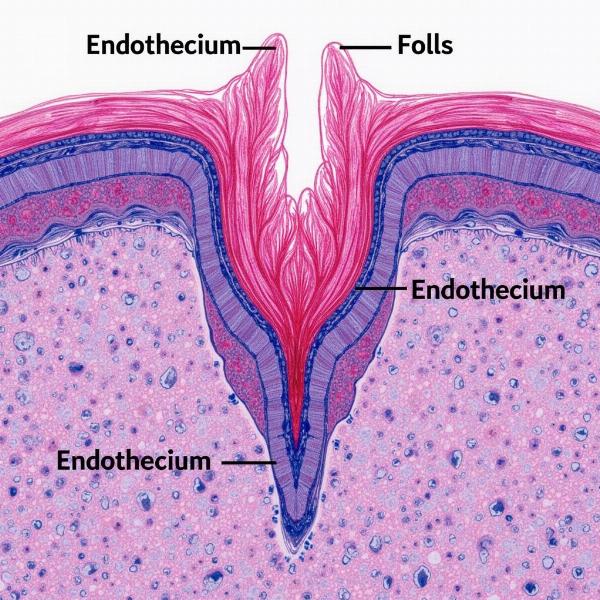Understanding the dehiscence of anther is crucial for grasping the intricacies of plant reproduction. This article will delve into the meaning of “dehiscence of anther” in Hindi, exploring its significance in botany and providing a comprehensive understanding of the process. We will examine the different types of dehiscence, their mechanisms, and their role in pollination.
What is Dehiscence of Anther?
“Dehiscence of anther” in Hindi is commonly referred to as परागकोश स्फुटन (parāgkosh sphuṭan). This essentially describes the process by which the anther, the pollen-bearing part of the stamen, opens to release pollen grains. This release is vital for pollination, the transfer of pollen to the stigma, which ultimately leads to fertilization and seed production.
Types of Anther Dehiscence
There are several ways an anther can dehisce, each with its own specific mechanism. Some of the common types include:
- Longitudinal Dehiscence: This is the most common type, where the anther splits lengthwise along its length.
- Transverse Dehiscence: In this type, the anther opens by a transverse slit across its width.
- Poricidal Dehiscence: Here, the pollen is released through small pores or openings at the apex of the anther.
- Valvular Dehiscence: This involves the detachment of small valves or flaps from the anther wall, revealing the pollen within.
Mechanism of Dehiscence
The mechanism of dehiscence is intricate and involves specific tissues within the anther wall. The endothecium, a layer of cells with thickened walls, plays a crucial role in the dehiscence process. As the anther matures, the endothecium cells lose water, causing differential shrinkage that leads to the rupture of the anther wall and the subsequent release of pollen.
 Endothecium's Role in Dehiscence
Endothecium's Role in Dehiscence
Significance of Dehiscence in Pollination
The timing and method of dehiscence are crucial for successful pollination. The process must be synchronized with the receptivity of the stigma to ensure that the pollen grains are viable when they reach the stigma. Furthermore, the type of dehiscence can influence the way pollen is dispersed, affecting which pollinators are attracted and how the pollen is transferred.
How does knowing about dehiscence benefit us?
Understanding anther dehiscence is crucial for plant breeders and agricultural scientists. It allows for the development of strategies to improve pollination efficiency, leading to increased crop yields and better quality produce.
Conclusion
Dehiscence of anther, known as परागकोश स्फुटन (parāgkosh sphuṭan) in Hindi, is a vital process in plant reproduction. The various types and mechanisms of dehiscence play a significant role in ensuring successful pollination, leading to the formation of seeds and the continuation of plant life. Understanding this process is essential for anyone interested in botany, agriculture, or the natural world.
FAQ
- What is the meaning of endothecium in Hindi? Endothecium is often referred to as अंतःस्तर (antaḥstara) in Hindi.
- What is the main function of the anther? The primary function of the anther is to produce and release pollen grains.
- How does dehiscence of anther affect seed production? Dehiscence allows for pollen release, which is essential for fertilization and subsequent seed production.
- What factors affect the timing of anther dehiscence? Environmental factors such as temperature and humidity can influence the timing of dehiscence.
- Why is pollination important? Pollination is essential for the reproduction of flowering plants, ensuring the continuation of plant species.
- What are some examples of plants with different types of dehiscence? Various plant species exhibit different types of dehiscence, such as longitudinal dehiscence in mustard and poricidal dehiscence in Solanum.
- Can dehiscence of anther occur without pollination? Yes, dehiscence is the release of pollen, while pollination is the transfer of pollen to the stigma. These are distinct but related processes.
Meaning-Hindi.in is your one-stop solution for all your Hindi translation needs. We specialize in various translation services, including Business and Commercial Document Translation, Certified and Legal Document Translation, Technical and User Manual Translation, Website and Localization Translation, Educational and Academic Document Translation, Express Translation, and Specialized Translation. As experts in Hindi language and Indian culture, we provide accurate and culturally sensitive translations. For inquiries, contact us at [email protected] or call us at +91 11-4502-7584. Meaning-Hindi.in is dedicated to bridging the language gap and facilitating clear communication.